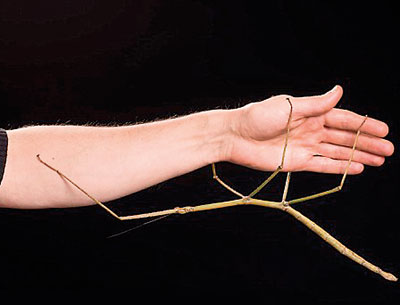Sunday Times 2
The stick insect so big that it looks like a branch
A stick insect measuring almost two feet long has been discovered by biologists in a remote jungle in Vietnam.
Entomologists working for the Royal Belgian Institute of Natural Sciences have announced the discovery of two new species and one subspecies of Phasmatodea – the scientific name for stick insects – found during their expeditions in the country’s remote forests.
The giant insect has also entered the record books – it is officially the second-largest stick insect ever found.
Measuring 32cm in length or 54cm with its legs spread, Phryganistria heusii yentuensis is closer in appearance to a small branch than a stick.
It is second in size only to a stick insect found in Borneo which measures more than 56cm with its legs outstretched.
The record breaking insect was found in the Tay Yen Tu Nature Reserve, 150km northeast of the Vietnam capital Hanoi.
Researchers found it during an expedition launched after they realised stick insects in Vietnam remain vastly understudied in scientific records.
Their method in capturing the insects was also remarkably basic – they beat trees with a pole until the insects fell to the ground.
Stick insects are mostly active at night and are adept at mimicking the form of sticks and leaves – even performing a rocking motion similar to that of a stick blowing in the wind.
The discovery is considered a giant step towards documenting the various types located in Vietnam, where only 70 species have so far been recorded.
Scientists responsible for the latest discovery alone collected hundreds during their recent expeditions, which need to be named and categorised – giving an indication as to the vast numbers yet to be discovered.
Southeast Asia is believed to have the greatest diversity of stick insects on the planet.
They are herbivores that feed on leaves, but are subject to predation themselves which they combat using a number of different defence mechanisms.
These include changing colours to suit their background like that of a chameleon, mimicking a branch in the wind by slowly swaying back and forth, or simply playing dead.
Stick insects are also known for remarkably long periods of copulation – some species have been known to remain paired for several months.
© Daily Mail, London

